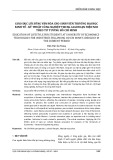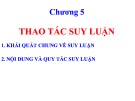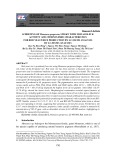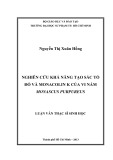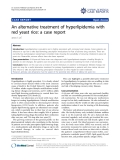
T
ẠP CHÍ KHOA HỌC
TRƯ
ỜNG ĐẠI HỌC SƯ PHẠM TP HỒ CHÍ MINH
Tập 21, Số 9 (2024): 1702-1712
HO CHI MINH CITY UNIVERSITY OF EDUCATION
JOURNAL OF SCIENCE
Vol. 21, No. 9 (2024): 1702-1712
ISSN:
2734-9918
Websit
e: https://journal.hcmue.edu.vn https://doi.org/10.54607/hcmue.js.21.9.4224(2024)
1702
Research Article1
SCREENING OF Monascus purpureus STRAIN WITH MONACOLIN K
ACTIVITY AND CITRININ-FREE CHARACTERISTICS
FOR RED YEAST RICE PRODUCTION BY LC-MS/MS ANALYSIS
BY LC-MS/MS ANALYSIS
Dao Nu Dieu Hong1*, Nguyen Thi Thuy Trang1, Nguyen Thi Dung1,
Bui Le Kha Tu1, Pham Thi Thanh Tinh2, Phan Thi Phuong Trang2, Ha Thi Loan1
1Biotechnology Center of Ho Chi Minh City, Ho Chi Minh City, Vietnam
2University of Science, Vietnam National University Ho Chi Minh City, Vietnam
*Corresponding author: Dao Nu Dieu Hong – Email: dndhong.snn@tphcm.gov.vn
Received: April 11, 2024; Revised: April 28, 2024; Accepted: May 21, 2024
ABSTRACT
Red yeast rice is produced from rice using Monascus purpureus fungus, which results in the
red colour of the fermented rice. Red yeast rice has been used for a thousand years as a food
preservative and in traditional medicine to support vascular and digestive health. The compound
known as monacolin K is the main active component that helps decrease blood cholesterol. However,
the byproduct of fermentation is citrinin, which causes hepato-nephrotoxic mycotoxin. This study
used Liquid Chromatography-Mass Spectrometry (LC-MS/MS) to concurrently analyse citrinin and
monacolin K produced by M. purpureus strain. The pigmentations were varied when cultured on
various media such as PDA, PGA, MGA, MCM, and SDAY media. MGA (61.12 – 1,996.20 AU/g)
and PGA (8.78 – 507.26 AU/g) displayed the highest levels of red pigment, while SDAY (10.55–
31.79 AU/g) showed the lowest levels. Morphological examination revealed typical features of
Monascus sp., including spherical or oval shapes and spore chains of two to four spores. Qualitative
analysis of chromatographic plates TLC revealed consistent bands of Monacolin K standard across
most strains, indicating their potential for producing this compound, with exceptions like strain BS3-
GLTT. Notably, strains C3.12, C5.17, C4.1, C1.15, and BS3-GLTT exhibited either faint or absent
spots corresponding to citrinin, suggesting their potential as citrinin-free strains. Furthermore, the
C5.17 strain identified as Monascus purpureus, under specific conditions, yielded a monacolin K
concentration of 292,32 ppm, with no detectable citrinin by LC-MS/MS analysis, highlighting its
suitability for monacolin K production.
Keywords: citrinin; monacolin K; Monascus purpureus; LC-MS/MS; Red yeast rice
1. Introduction
Monascus sp. belongs to the Monascaceae family, genus Monascus, which is one of
the species capable of producing natural bioactive pigments (Mussalbakri et al., 2017).
Cite this article as: Dao Nu Dieu Hong, Nguyen Thi Thuy Trang, Nguyen Thi Dung, Bui Le Kha Tu, Pham Thi
Thanh Tinh, Phan Thi Phuong Trang, & Ha Thi Loan (2024). Screening of Monascus purpureus strain with
monacolin K activity and citrinin-free characteristics for Red yeast rice production by LC-MS/MS analysis by
LC-MS/MS analysis. Ho Chi Minh City University of Education Journal of Science, 21(9), 1702-1712.





